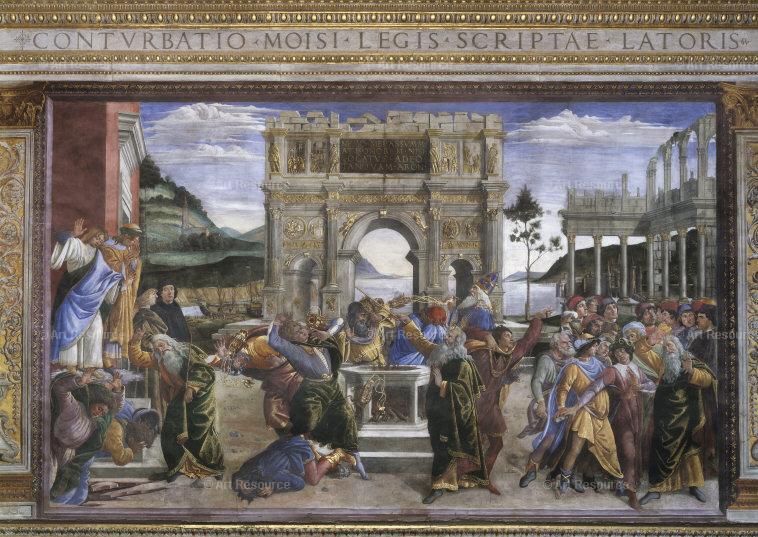The Punishment of the Sons of Korah, 1480-1482
Following a common practice in paintings, the Punishment of the Sons of Korah (1480-1482), or the Punishment of Korah, Dathan, and Abiram, is organized as a synoptic narrative, containing within a single picture plane multiple scenes from the Biblical story of Moses (see Appendix Image 1). The fresco depicts three episodes across a united landscape and picture plane. Moses, as the central figure, is shown three times and is dressed in gold and green with rays above his head. In the bottom left corner, Moses watches on as the earth opens and swallows those who challenged Aaron’s role as a high priest chosen by God and subsequently assumed his position. In the center, six figures offer false fire to God and are met with fires from Heaven while Moses, in the foreground of the scene, looks up towards the Lord. On the right, Moses tries to seek refuge from Israelites who sought to stone him. Anachronistically, Aaron is seen in the central image in a papal tiara. These images depict the “fatal consequences” endured by Korah and his supporters who “presumptuously challenged the supremacy of Moses and Aaron, the Lord’s chosen representatives among the Jews”.[1]
Much like his predecessors, the Pope is God’s chosen representative on Earth. This fresco belongs to a series depicting Moses’ life which parallel a fresco cycle of Jesus’ life. In Christian iconography, Moses is often viewed as a prefiguration of Christ. The Punishment of the Sons of Korah was commissioned by Pope Sixtus IV and decorated the new papal chapel and was completed on the anniversary of his elevation; 9 August 1483.[2] Frederick Hartt and David Wilkins assert that “this unusual subject would clearly appeal to a patron interested in asserting his authority”.[3] This fresco serves to reinforce the Pope’s supremacy and absolute authority as the head of the Church of Rome. After having been implicated in the Pazzi Conspiracy and attempting to excommunicate Lorenzo de’ Medici and Florence, Sixtus IV would certainly want to remind viewers of his power. By placing Aaron in a papal tiara and standing in front of the Arch of Constantine with an inscription from Hebrews 5:4: “‘And no man taketh this honour unto himself, but he that is called of God, as was Aaron’”[4], the fresco, depicting episodes from the Old Testament and recognizable iconography from the Roman Empire, places the Papacy and its leader above temporal powers. Thus, the iconography of Botticelli’s fresco equates the Pope with Moses. Ronald Lightbown describes the fresco as both a “narrative and a lesson”, noting that the warning on the Arch of Constantine taken from Hebrews was intentionally altered to convey a more serious tone.[5] Moreover, this Biblical episode was frequently referred to and cited by those who defended papal supremacy and served as a reminder of the judgement awaiting those who did not.[6]
Botticelli was one of many Florentine painters commissioned by Sixtus IV to carry out the fresco cycle in the Sistine Chapel. Andreas Schumacher proposes a specific connection, in the aftermath of the Pazzi Conspiracy, between the frescoes and the Florentine artists who painted them. The violent actions carried out by Florentines and the Medici in retaliation against the conspirators prompted the Pope to issue a papal bull which threatened the religious lives of the city and its ruling family. Florence and the Holy See were essentially at war. After gaining papal absolution, it is possible that Lorenzo and Pope Sixtus IV wanted to repair their relationship. Botticelli was a prominent fixture at the Medici court and worked exclusively in Florence; the Sistine Chapel frescoes are “the only commission carried out by the artist outside his native town”.[7] Based on this, Schumacher argues that Lorenzo and the Pope could have agreed on the employment of Florentine artists in Rome during “peace negotiations” between the two powerful Italian city states.[8] Despite the Pope’s suspected involvement in the assassination attempt and his efforts towards excommunication, Lorenzo remained in control of his beloved city. This fresco done by famous Florentine hands is filled with “symbolic emphasis”[9] regarding the Pope and his holy authority. However, Lorenzo’s likely involvement in arranging for Botticelli and other Florentine painters to work in Rome also serves as a reminder that Florence still belonged to the Medici and that this attack on their power, and the subsequent papal bull, had not been successful.
[1] Lewine, Carol F. “‘Punishment of Korah’ and the ‘Sede Vacante’.” Notes in the History of Art, winter 1990, vol. 9, no. 2 (winter 1990), (14-18), p. 16.
[2] Lewine, “‘Punishment of Korah’ and the ‘Sede Vacante’.”, p. 15.
[3] Hartt, Frederick and David G Wilkins. History of Italian Renaissance Art: Painting, Sculpture, Architecture.
6th ed, Pearson Prentice Hall, New Jersey, 2007, pp. 339-340.
[4] Quoted in: Hartt and Wilkins, History of Italian Renaissance Art p. 340.
[5] Lightbown, Ronald, Sandro Botticelli: Life and Work, (rev. ed.), Thames and Hudson, 1989, pp. 102, 105.
[6] Lightbown, Sandro Botticelli, p. 105.
[7] Schumacher, Andreas. “The Painter Sandro Botticelli: An Introduction to his Oeuvre”, in
Botticelli: Likeness, Myth, Devotion, An Exhibition Organized by the Städel Museum,
Frankfurt Am Main. Ed. Andreas Schumacher, November 13, 2009-February 28, 2010. Ostfildern, Germany: Hatje/Cantz, 2009, (15-56), p. 40.
[8] Schumacher, “The Painter Sandro Botticelli”, p. 40.
[9] Lightbown, Sandro Botticelli, p. 111.
